Physical Address
304 North Cardinal St.
Dorchester Center, MA 02124
Physical Address
304 North Cardinal St.
Dorchester Center, MA 02124

Curious about New Zealand's spectacular native wildlife? These 11 remarkable creatures showcase the country's extraordinary biodiversity.
New Zealand boasts extraordinary native wildlife you won’t find elsewhere. Look for the flightless kiwi, ancient tuatara reptiles, and playful fur seals along rocky coastlines. Don’t miss the intelligent kea parrot, melodious tui with white throat tufts, and critically endangered native bats. Yellow-eyed penguins, Hector’s dolphins, and unique reptiles like geckos and skinks complete your wildlife checklist. Discover these remarkable creatures in their natural habitats and learn why conservationists work tirelessly to protect them.
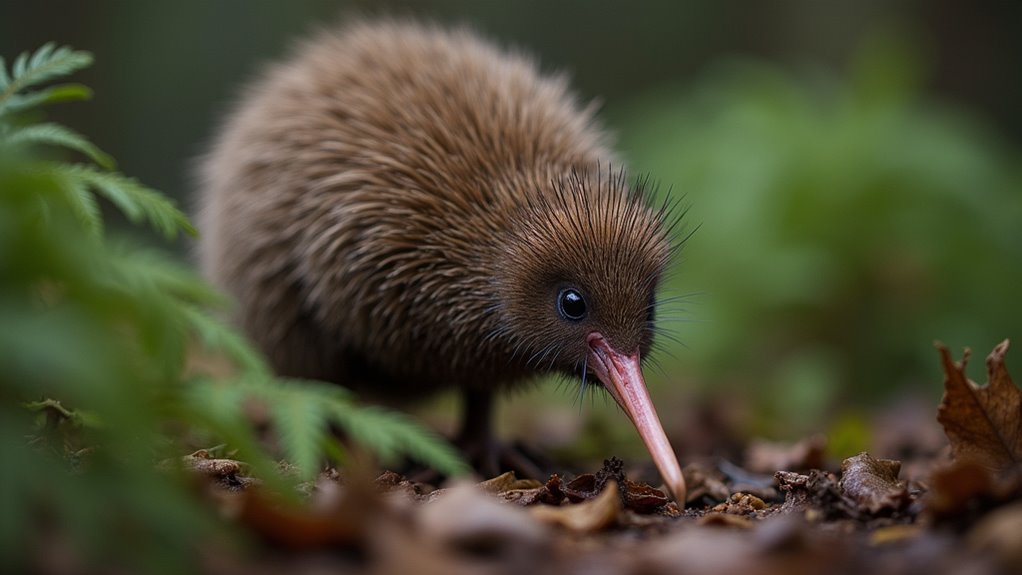
Although many countries have remarkable wildlife, New Zealand’s kiwi stands as a truly distinctive national emblem. This flightless, nocturnal bird exists nowhere else in the world and has become synonymous with New Zealand identity.
You’ll recognize kiwis by their hair-like feathers, strong legs, and lack of tail. Despite poor eyesight, they navigate using an excellent sense of smell through nostrils at the tip of their beak.
They’re prolific burrowers, with some individuals using over 50 different burrows.
All five kiwi species face threats from introduced predators like stoats and cats. The smallest kiwi species remains vulnerable to stoats throughout all stages of its life. Conservation efforts, often in partnership with Māori who consider the bird a taonga (treasure), have helped some populations recover on predator-free islands.
Look for this iconic bird featured on New Zealand’s currency and military insignia. Visitors to New Zealand can learn about kiwi conservation efforts at Rotorua’s sanctuaries while exploring this must-visit destination.
While many ancient species have vanished from Earth, New Zealand’s tuatara stands as a remarkable exception. This reptile is the sole survivor of an order that thrived 190 million years ago during the Jurassic period. You’ll be fascinated by these living fossils that have changed little over millions of years. The tuatara’s distinctive skull structure includes a complete lower bar that stabilizes it during biting, an adaptation not found in modern lizards. These unique creatures are considered one of the must-see attractions when visiting New Zealand’s protected islands.
Nature’s enduring anomaly, the tuatara defies extinction as a living window into Earth’s prehistoric past.
Once widespread across New Zealand, tuatara now primarily inhabit offshore islands, though conservation efforts have recently returned them to mainland areas.
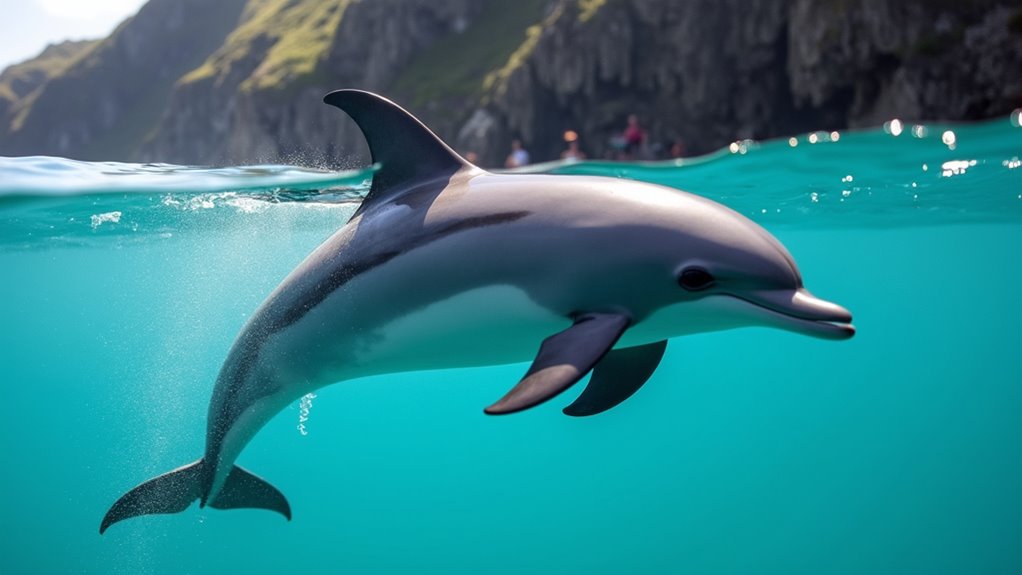
Nestled in the coastal waters of New Zealand lives Hector’s dolphin, the world’s smallest marine dolphin species. You’ll find these endangered creatures primarily around New Zealand’s South Island, between Marlborough Sounds and Otago Peninsula on the east coast, and from Jackson Bay to Kahurangi Point on the west.
At just 1.45 meters long and weighing between 40-60 kg, these dolphins are smaller than the average human. You can identify them by their distinctive grey bodies with black and white markings and rounded dorsal fins.
They’re naturally playful and acrobatic, typically swimming in small groups. Local residents often call them mickey mouse dolphins due to their distinctive rounded dorsal fins that resemble mouse ears.
These marine mammals are one of the many native species that make New Zealand’s wildlife so distinctive and worth protecting.
With only about 7,000 individuals remaining, conservation efforts focus on reducing bycatch in fishing nets and protecting their coastal habitats.
High in the mountains of New Zealand’s South Island, you’ll encounter the remarkable kea, the world’s only alpine parrot species. These endangered birds, protected since 1986, are known for their extraordinary intelligence and playful curiosity.
Discover the kea—New Zealand’s endangered alpine parrot, whose intelligence and curiosity rival their breathtaking mountain habitat.
When spotting kea, look for:
You’ll find these clever omnivores from Golden Bay to Fiordland, foraging on everything from berries to insects and occasionally carrion. Their problem-solving abilities and tool use demonstrate why they’re considered among the world’s smartest birds. Nicknamed the “clown of the mountains,” kea are famous for their mischievous habits of investigating and sometimes damaging visitors’ backpacks and cars.
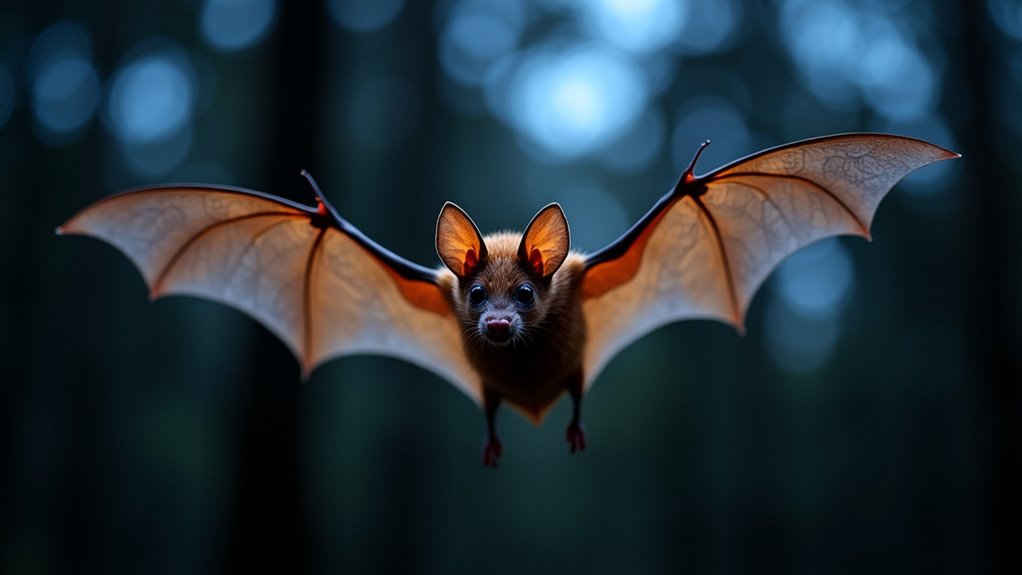
Among all of New Zealand’s fascinating wildlife, the native bats stand out as truly exceptional—they’re the only native land mammals to have ever inhabited these isolated islands. Two species call New Zealand home: the long-tailed bat and the lesser short-tailed bat, both facing serious conservation challenges.
You’ll recognize the long-tailed bat by its thumb-sized body (5-6 cm), 30 cm wingspan, and distinctive tail connected to its hind legs. Females typically display chestnut-colored fur with white tips, while males are darker.
Known as “pekapeka” in Māori culture, these nationally critical creatures play essential roles as pollinators and insectivores. While the greater short-tailed bat is likely extinct, conservation efforts continue for the remaining species. You might spot them foraging along forest edges at night, but urbanization threatens their survival.
Conservation efforts focus on protecting their forest habitats across both main islands. Many people considering New Zealand living cite the country’s unique wildlife and conservation initiatives as significant factors in their decision to relocate.
While New Zealand’s unique bats dominate the mammalian story, the forest floor below tells an equally extraordinary tale through its giant insects. Weta are endemic insects found nowhere else on Earth, with over 70 species across five main groups: tusked, tree, cave, giant, and ground weta.
The impressive giant weta can reach lengths of 100mm and weigh up to 30g (with one captive specimen reaching a record 70g). These remarkable creatures:
Look for these forest giants in protected areas throughout New Zealand’s diverse habitats. Many weta species, particularly tree weta, are nocturnal creatures that make homes in tree holes or rotting wood during daylight hours. Unlike the cities of East Coast Australia, New Zealand offers unique opportunities to observe these prehistoric-looking insects in their natural environment.
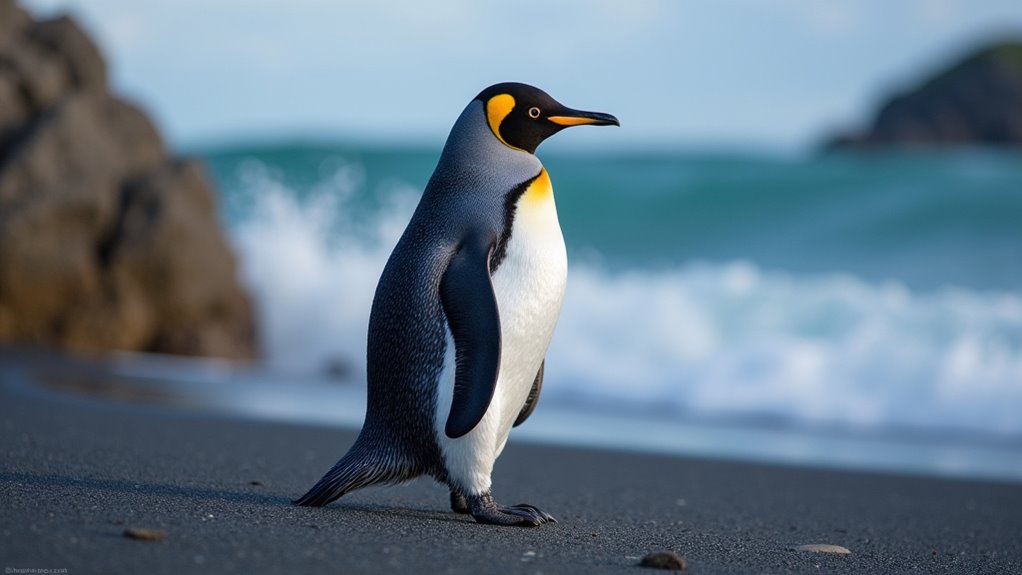
The distinctive yellow-eyed penguin, known as hoiho in Māori, is prominent as one of New Zealand’s most precious and imperiled wildlife treasures. You’ll find these endangered birds primarily along the South Island’s southeast coast, Otago Peninsula, and subantarctic islands.
Unlike most penguins that nest in dense colonies, hoiho prefer solitary nesting in coastal forests and scrub.
Their population has declined dramatically—76% since 1996—with only about 3,400 breeding pairs remaining.
When visiting breeding areas, maintain a respectful distance as human disturbance threatens their survival, alongside predation from introduced mammals and habitat loss.
The Enderby Island population represents nearly half of all yellow-eyed penguins, making conservation efforts in these regions particularly essential for the species’ future.
These penguins are an important part of Māori traditions and cultural heritage in New Zealand.
The Yellow-eyed Penguin Trust extends sincere appreciation to all who become official supporters, as these contributions directly fund crucial habitat preservation initiatives.
New Zealand’s forests ring with melodious calls of the tui, a remarkable native songbird instantly recognizable by its distinctive white throat tufts against iridescent green-blue-purple plumage. You’ll find these charismatic birds throughout the North, South, and Stewart Islands, particularly in areas with flowering and fruiting trees.
The tui’s melodic song fills New Zealand forests, its white throat tufts and shimmering plumage unmistakable among native trees.
What makes the tui truly special:
The tui’s down-curved beak has evolved to fit perfectly into native flowers for efficient nectar feeding. The Chatham Island subspecies is notably larger than mainland populations, with different singing patterns reflecting their isolated evolution. Tuis thrive in New Zealand despite the country harboring some hazardous wildlife areas where other native species face greater challenges.
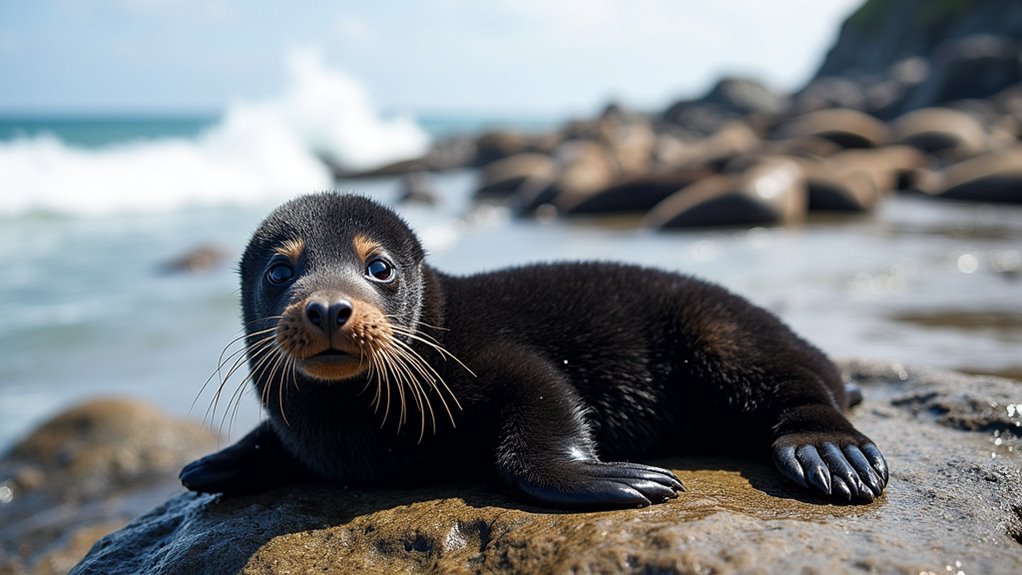
Along New Zealand’s rugged coastlines, you’ll encounter another iconic native species that’s just as enthralling as the melodious tui but thrives where land meets sea.
You’ll find these playful mammals primarily along the South Island’s southern and western shores, where they gather on rocky ledges and offshore islands. Males are markedly larger than females—weighing up to 350 pounds compared to the females’ modest 88 pounds.
These skilled nocturnal hunters dive impressively deep, with females reaching depths of 780 feet for nearly 11 minutes—a record among fur seals. Their diet includes squid, mackerel, and barracuda. After experiencing New Zealand, you might also appreciate the country’s rich food culture which contrasts with the seal’s seafood diet. After a near brush with extinction due to 19th century hunting, the species has rebounded from very low numbers to approximately 200,000 individuals today.
Though once endangered, these social creatures are now recovering. During your coastal explorations, listen for their distinctive vocalizations as they communicate in their rocky habitats.
Lurking within New Zealand’s ancient forests and rocky outcrops, you’ll discover some of the world’s most distinctive reptiles that exist nowhere else on Earth. These endemic lizards belong to the Squamata order but differ markedly in their appearance and behaviors.
Unlike Australia’s coastal regions, New Zealand’s isolated evolution has produced reptiles with unique adaptations to its specific environment.
New Zealand is home to an impressive 126 species of native lizards that are fully protected under the Wildlife Act 1953.
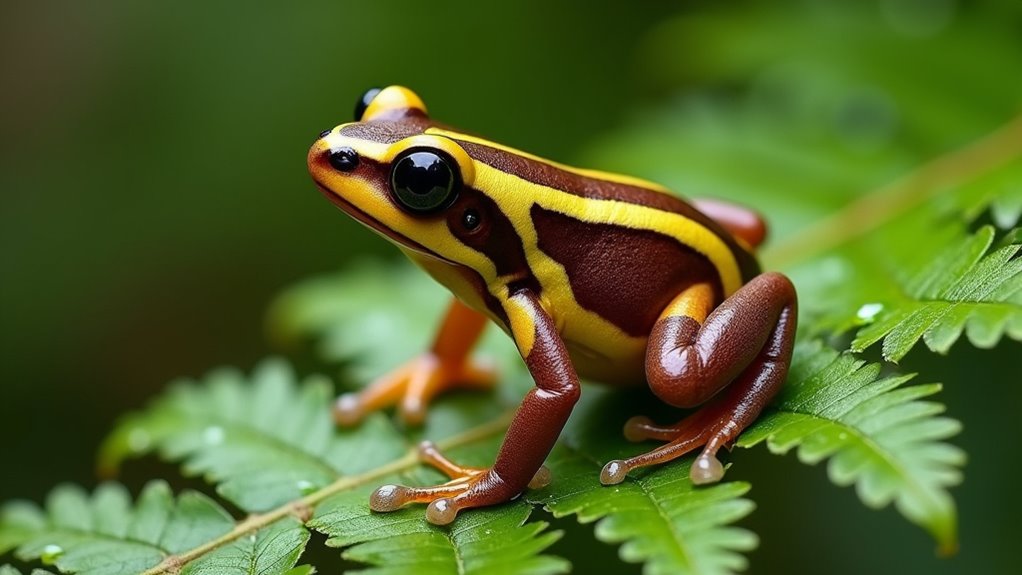
While New Zealand‘s reptiles represent unique evolutionary adaptations to island life, there’s an intriguing amphibian that warrants attention despite not being native to these shores. The Striped Rocket Frog isn’t found in New Zealand naturally, as its range primarily covers Australia and Papua New Guinea. Unlike New Zealand, which is famously free of snakes, these frogs have evolved alongside reptilian predators in their native habitats.
This remarkable jumper reaches 55mm in length but can leap up to 2 meters—an impressive 36 times its body length! Despite being classified as a tree frog, it’s mainly ground-dwelling due to its small toe discs limiting climbing ability. The species is particularly visible in coastal areas from Western Australia to New South Wales, with an isolated population in Avalon.
During wet seasons, males attract mates with distinctive “wick…wick” calls, followed by “but…but” sounds. Their brown dorsal surface features darker longitudinal folds, while their underside remains white and granular, helping them blend into their preferred habitats near swamps and flooded grasslands.
New Zealand’s unique wildlife offers encounters you won’t find elsewhere on Earth. When planning your visit, remember that dawn and dusk provide ideal viewing opportunities for many native species. At Zealandia Sanctuary in Wellington, visitors regularly spot multiple kiwi during guided night tours, proving conservation efforts are working. By respecting wildlife habitats and supporting local conservation initiatives, you’ll help guarantee these remarkable creatures thrive for generations to come.